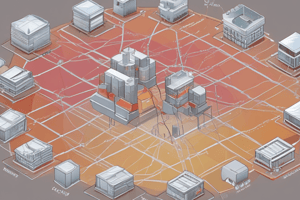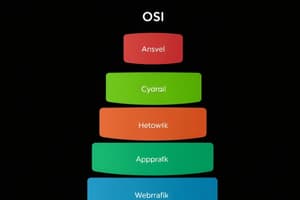Podcast
Questions and Answers
What is the key function of the network layer in the OSI model?
What is the key function of the network layer in the OSI model?
- Error checking and correction
- Assigning MAC addresses
- Creating logical links for data transfer
- Providing flow control and congestion avoidance mechanisms (correct)
Which layer is responsible for defining electrical, mechanical, and procedural hardware standards in the OSI model?
Which layer is responsible for defining electrical, mechanical, and procedural hardware standards in the OSI model?
- Physical Layer (correct)
- Data Link Layer
- Session Layer
- Transport Layer
What is the primary purpose of MAC addresses in a local area network (LAN)?
What is the primary purpose of MAC addresses in a local area network (LAN)?
- Implementing error detection techniques
- Ensuring proper delivery of Ethernet frames (correct)
- Establishing end-to-end communication between applications
- Controlling data transmission rates
Which layer provides error checking and correction services to ensure reliable communication between applications in the OSI model?
Which layer provides error checking and correction services to ensure reliable communication between applications in the OSI model?
In an Ethernet frame transmission, which layer conceals physical failures and creates logical links?
In an Ethernet frame transmission, which layer conceals physical failures and creates logical links?
What is one of the key responsibilities of the Session Layer in the OSI model?
What is one of the key responsibilities of the Session Layer in the OSI model?
Which of the following protocols is commonly associated with the Session Layer of the OSI model?
Which of the following protocols is commonly associated with the Session Layer of the OSI model?
What is the primary function of the Data Link layer in the OSI model?
What is the primary function of the Data Link layer in the OSI model?
Which layer of the OSI model is responsible for logical addressing and routing?
Which layer of the OSI model is responsible for logical addressing and routing?
What does the Transport Layer ensure in terms of data transmission?
What does the Transport Layer ensure in terms of data transmission?
Flashcards are hidden until you start studying
Study Notes
Overview of OSI Model Layers: Session, Network, Physical, Data Link, Transport
The Open Systems Interconnection (OSI) model is a theoretical framework used by network engineers to understand how different communication components interact with each other. It consists of seven distinct layers, each providing specific services and interfaces to users in the layer above it. This article describes these five central layers of the OSI model - Session, Network, Physical, Data Link, and Transport - and their functions in detail.
Session Layer
The session layer manages the dialogues between applications and provides mechanisms for establishing, managing, and terminating connections between them. Some common protocols associated with this layer include NetBIOS, NFS, TELNET, FTP, SMTP, SNMP, and SSH. A few key responsibilities of the session layer are:
- Negotiating data formats and conventions for the application layer.
- Creating, maintaining, and terminating sessions between applications.
- Managing connectionless interactions and synchronizing transmission modes.
Example Usage: FTP Example
FTP (File Transfer Protocol), which runs over TCP at the transport layer, uses a service interaction point within the session layer to establish a connection between two computers. These interactions allow file transfers to take place securely and reliably.
Network Layer
The network layer handles routing messages from one host to another, ensuring correct delivery even when multiple paths exist between hosts. Key functions of the network layer include:
- Routing traffic to its destination based on logical addressing, such as IP addresses.
- Providing flow control and congestion avoidance mechanisms.
- Enabling packet fragmentation and reassembly if needed.
Example Usage: Packet Fragmentation
Consider a large file transfer scenario where the sender's maximum transmission unit (MTU) is smaller than the recipient's MTU. In this case, the network layer will break down the larger packets into smaller ones (fragmentation), allowing the recipient to receive and process the entire file successfully.
Physical Layer
At the bottom of the OSI stack lies the physical layer, responsible for transmitting raw bit streams over a physical medium. Its main functions include:
- Defining electrical, mechanical, functional, and procedural standards for the hardware interface.
- Implementing basic error detection techniques like parity checking.
- Transmitting and receiving data bits using the appropriate encoding schemes.
Example Usage: Bit Error Detection
When sending data through copper wire, errors may occur due to electromagnetic interference or faulty connections. To detect potential bit errors, the physical layer employs methods like cyclic redundancy checks (CRCs). If a CRC mismatch occurs, the receiver requests retransmission of the affected segment.
Data Link Layer
Situated just above the physical layer, the data link layer establishes reliable connections between devices connected via a single physical medium. Functions of this layer include:
- Identifying unique addresses (MAC addresses) for devices.
- Concealing physical failures, creating logical links.
- Encapsulating frames for error detection and recovery.
Example Usage: MAC Addresses
In a local area network (LAN), each device has a unique MAC address assigned by the manufacturer during production. When an Ethernet frame is sent across the network, its source and destination MAC addresses help ensure proper delivery and prevent collisions.
Transport Layer
The transport layer provides end-to-end communication services between applications in different processes. Some essential tasks performed by this layer are:
- Ensuring reliability through error checking and correction.
- Controlling access and regulating the rate of data transmission.
- Establishing connections between applications running on different machines.
Example Usage: Connection Control
TCP, a widely used protocol at the transport layer, establishes a virtual connection between two computers before starting the actual data transfer. This initial handshake includes a three-way exchange of acknowledgments, verifying both ends agree on the parameters required for efficient communication.
Studying That Suits You
Use AI to generate personalized quizzes and flashcards to suit your learning preferences.




